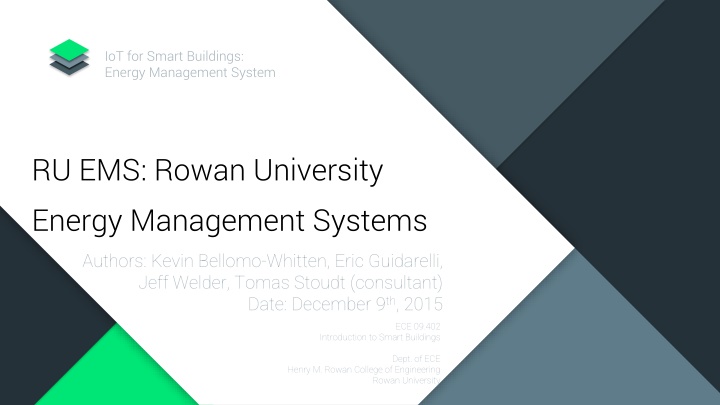
Smart Buildings Energy Management System at Rowan University
"Explore the IoT for Smart Buildings project at Rowan University, focusing on energy management systems and the benefits of smart building architecture. Learn about renewable energy integration and user independence for enhanced utility benefits in this innovative system design." (277 characters)
Download Presentation

Please find below an Image/Link to download the presentation.
The content on the website is provided AS IS for your information and personal use only. It may not be sold, licensed, or shared on other websites without obtaining consent from the author. If you encounter any issues during the download, it is possible that the publisher has removed the file from their server.
You are allowed to download the files provided on this website for personal or commercial use, subject to the condition that they are used lawfully. All files are the property of their respective owners.
The content on the website is provided AS IS for your information and personal use only. It may not be sold, licensed, or shared on other websites without obtaining consent from the author.
E N D
Presentation Transcript
IoT for Smart Buildings: Energy Management System RU EMS: Rowan University Energy Management Systems Authors: Kevin Bellomo-Whitten, Eric Guidarelli, Jeff Welder, Tomas Stoudt (consultant) Date: December 9th, 2015 ECE 09.402 Introduction to Smart Buildings Dept. of ECE Henry M. Rowan College of Engineering Rowan University
Rowan University Energy Management Systems Internet of Things for Smart Buildings Outline REQUIREMENTS AND SOLUTION ARCHITECTURE REQUIREMENTS AND SOLUTION ARCHITECTURE SOFTWARE AND HARDWARE DESIGN INTRODUCTION AND APPLICATION SOFTWARE AND HARDWARE DESIGN OUTLINE FUNCTIONAL VV CONCLUSIONS INTRODUCTION AND APPLICATION OUTLINE FUNCTIONAL V&V CONCLUSIONS 2 10 15 17 3 7 Software and Hardware Design Project Schematic: Block Diagram Software Architecture: Top Level Software Architecture: Send/Receive Data Software Architecture: ADC on the Pi Functional V&V Conclusions Introduction and Application Benefits of a Smart Building Architecture Utilize Smart Building Benefits Smart Energy Management System Requirements and Solution Architecture Project Requirements Analysis of Project Requirements Results Comparison Future Work and Conclusions
Introduction and Application
Rowan University Energy Management Systems Internet of Things for Smart Buildings Benefits of a Smart Building Architecture REQUIREMENTS AND SOLUTION ARCHITECTURE REQUIREMENTS AND SOLUTION ARCHITECTURE SOFTWARE AND HARDWARE DESIGN INTRODUCTION AND APPLICATION SOFTWARE AND HARDWARE DESIGN OUTLINE FUNCTIONAL VV CONCLUSIONS INTRODUCTION AND APPLICATION OUTLINE FUNCTIONAL V&V CONCLUSIONS 4 Renewable Energy User Independence Utility Benefits Adding a renewable energy source can supplement a buildings electrical loads End user can draw power from their renewable technologies, or export energy to the grid for cost savings More local resources to draw power from to help stabilize their grid
Rowan University Energy Management Systems Internet of Things for Smart Buildings Utilize Smart Building Benefits REQUIREMENTS AND SOLUTION ARCHITECTURE REQUIREMENTS AND SOLUTION ARCHITECTURE SOFTWARE AND HARDWARE DESIGN INTRODUCTION AND APPLICATION SOFTWARE AND HARDWARE DESIGN OUTLINE FUNCTIONAL VV CONCLUSIONS INTRODUCTION AND APPLICATION OUTLINE FUNCTIONAL V&V CONCLUSIONS 5 Real-Time Pricing Having alternative energy sources to pull from during the grids peak pricing times can lower total energy costs http://www.citizensutilityboard.org/images/rtp_comed2.jpg
Rowan University Energy Management Systems Internet of Things for Smart Buildings Smart Energy Management System REQUIREMENTS AND SOLUTION ARCHITECTURE REQUIREMENTS AND SOLUTION ARCHITECTURE SOFTWARE AND HARDWARE DESIGN INTRODUCTION AND APPLICATION SOFTWARE AND HARDWARE DESIGN OUTLINE FUNCTIONAL VV CONCLUSIONS INTRODUCTION AND APPLICATION OUTLINE FUNCTIONAL V&V CONCLUSIONS 6 Monitor Grid Set Preferences Smart Responses Gather relevant data from the grid like time-based energy rates, cloud coverage, and sunrise/sunset times Create rules that determine where to take power from or when to sell energy back to the grid based on gathered data Change the source of energy for system
Requirements and Solution Architecture
Rowan University Energy Management Systems Internet of Things for Smart Buildings Project Requirements REQUIREMENTS AND SOLUTION ARCHITECTURE REQUIREMENTS AND SOLUTION ARCHITECTURE SOFTWARE AND HARDWARE DESIGN INTRODUCTION AND APPLICATION SOFTWARE AND HARDWARE DESIGN OUTLINE FUNCTIONAL VV CONCLUSIONS INTRODUCTION AND APPLICATION OUTLINE FUNCTIONAL V&V CONCLUSIONS 8 Simulate a micro grid over a one day time-span Utility power Renewable energy source Energy storage unit Monitoring system Generate mock input data for monitoring system Communicate between monitoring system the simulation Monitoring System To fit the project in the constraints of a one- semester timeframe, only the monitoring portion of the system was made
Rowan University Energy Management Systems Internet of Things for Smart Buildings Analysis of Requirements REQUIREMENTS AND SOLUTION ARCHITECTURE REQUIREMENTS AND SOLUTION ARCHITECTURE SOFTWARE AND HARDWARE DESIGN INTRODUCTION AND APPLICATION SOFTWARE AND HARDWARE DESIGN OUTLINE FUNCTIONAL VV CONCLUSIONS INTRODUCTION AND APPLICATION OUTLINE FUNCTIONAL V&V CONCLUSIONS 9 Simulation Type Monitoring System Communication MathWorks has a toolbox for the SimuLink program that has power grid components A Raspberry Pi was chosen as the monitoring system that would gather the mock relevant data The simulation and monitoring system should communicate over wireless User Datagram Protocol (UDP)
Software and Hardware Design
Project Schematic Block Diagram A set of loads tied to an existing service, battery block, PV array, and management system are shown in this schematic 11
Rowan University Energy Management Systems Internet of Things for Smart Buildings Future Work and Conclusion REQUIREMENTS AND SOLUTION ARCHITECTURE REQUIREMENTS AND SOLUTION ARCHITECTURE SOFTWARE AND HARDWARE DESIGN INTRODUCTION AND APPLICATION SOFTWARE AND HARDWARE DESIGN OUTLINE FUNCTIONAL VV CONCLUSIONS INTRODUCTION AND APPLICATION OUTLINE FUNCTIONAL V&V CONCLUSIONS 18 Energy Storage Weather API Conclusion Built-in energy storage blocks in Simulink did not realistically simulate storing energy Including free weather APIs that could provide information on cloud coverage, reducing PV arrays effectiveness Two working components, but issues communicating between live sensor UDP and simulation UDP kept them separate
Questions? 19
